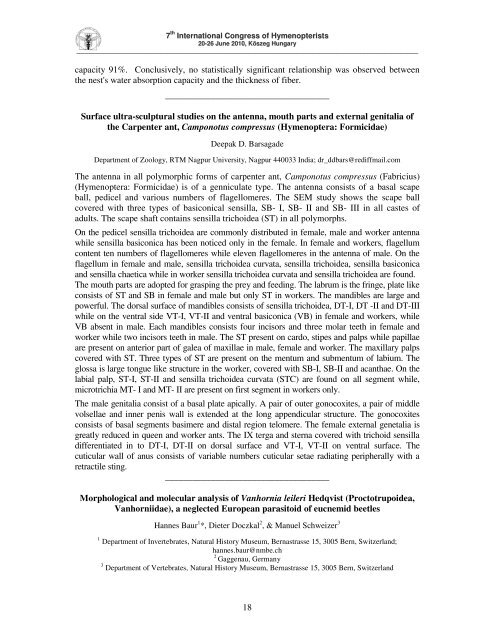Seventh International Congress of Hymenopterists
Seventh International Congress of Hymenopterists
Seventh International Congress of Hymenopterists
You also want an ePaper? Increase the reach of your titles
YUMPU automatically turns print PDFs into web optimized ePapers that Google loves.
7 th <strong>International</strong> <strong>Congress</strong> <strong>of</strong> <strong>Hymenopterists</strong><br />
20-26 June 2010, Kszeg Hungary<br />
_____________________________________________________________________________________________________<br />
capacity 91%. Conclusively, no statistically significant relationship was observed between<br />
the nest's water absorption capacity and the thickness <strong>of</strong> fiber.<br />
____________________________________<br />
Surface ultra-sculptural studies on the antenna, mouth parts and external genitalia <strong>of</strong><br />
the Carpenter ant, Camponotus compressus (Hymenoptera: Formicidae)<br />
Deepak D. Barsagade<br />
Department <strong>of</strong> Zoology, RTM Nagpur University, Nagpur 440033 India; dr_ddbars@rediffmail.com<br />
The antenna in all polymorphic forms <strong>of</strong> carpenter ant, Camponotus compressus (Fabricius)<br />
(Hymenoptera: Formicidae) is <strong>of</strong> a genniculate type. The antenna consists <strong>of</strong> a basal scape<br />
ball, pedicel and various numbers <strong>of</strong> flagellomeres. The SEM study shows the scape ball<br />
covered with three types <strong>of</strong> basiconical sensilla, SB- I, SB- II and SB- III in all castes <strong>of</strong><br />
adults. The scape shaft contains sensilla trichoidea (ST) in all polymorphs.<br />
On the pedicel sensilla trichoidea are commonly distributed in female, male and worker antenna<br />
while sensilla basiconica has been noticed only in the female. In female and workers, flagellum<br />
content ten numbers <strong>of</strong> flagellomeres while eleven flagellomeres in the antenna <strong>of</strong> male. On the<br />
flagellum in female and male, sensilla trichoidea curvata, sensilla trichoidea, sensilla basiconica<br />
and sensilla chaetica while in worker sensilla trichoidea curvata and sensilla trichoidea are found.<br />
The mouth parts are adopted for grasping the prey and feeding. The labrum is the fringe, plate like<br />
consists <strong>of</strong> ST and SB in female and male but only ST in workers. The mandibles are large and<br />
powerful. The dorsal surface <strong>of</strong> mandibles consists <strong>of</strong> sensilla trichoidea, DT-I, DT -II and DT-III<br />
while on the ventral side VT-I, VT-II and ventral basiconica (VB) in female and workers, while<br />
VB absent in male. Each mandibles consists four incisors and three molar teeth in female and<br />
worker while two incisors teeth in male. The ST present on cardo, stipes and palps while papillae<br />
are present on anterior part <strong>of</strong> galea <strong>of</strong> maxillae in male, female and worker. The maxillary palps<br />
covered with ST. Three types <strong>of</strong> ST are present on the mentum and submentum <strong>of</strong> labium. The<br />
glossa is large tongue like structure in the worker, covered with SB-I, SB-II and acanthae. On the<br />
labial palp, ST-I, ST-II and sensilla trichoidea curvata (STC) are found on all segment while,<br />
microtrichia MT- I and MT- II are present on first segment in workers only.<br />
The male genitalia consist <strong>of</strong> a basal plate apically. A pair <strong>of</strong> outer gonocoxites, a pair <strong>of</strong> middle<br />
volsellae and inner penis wall is extended at the long appendicular structure. The gonocoxites<br />
consists <strong>of</strong> basal segments basimere and distal region telomere. The female external genetalia is<br />
greatly reduced in queen and worker ants. The IX terga and sterna covered with trichoid sensilla<br />
differentiated in to DT-I, DT-II on dorsal surface and VT-I, VT-II on ventral surface. The<br />
cuticular wall <strong>of</strong> anus consists <strong>of</strong> variable numbers cuticular setae radiating peripherally with a<br />
retractile sting.<br />
____________________________________<br />
Morphological and molecular analysis <strong>of</strong> Vanhornia leileri Hedqvist (Proctotrupoidea,<br />
Vanhorniidae), a neglected European parasitoid <strong>of</strong> eucnemid beetles<br />
Hannes Baur 1 *, Dieter Doczkal 2 , & Manuel Schweizer 3<br />
1 Department <strong>of</strong> Invertebrates, Natural History Museum, Bernastrasse 15, 3005 Bern, Switzerland;<br />
hannes.baur@nmbe.ch<br />
2 Gaggenau, Germany<br />
3 Department <strong>of</strong> Vertebrates, Natural History Museum, Bernastrasse 15, 3005 Bern, Switzerland<br />
18


